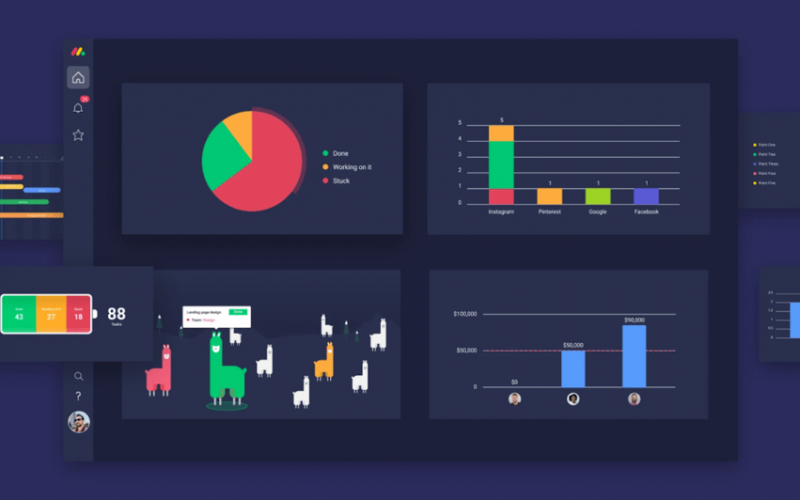Issue tracking systems are frequently used in the institutional context in customer care call centers to record, update, and address client issues as well as issues reported by other employees of the business. Important details about the account involved and the problem encountered should be included in a support ticket. Read on to learn about the best tracker software and app.
What is Issue Tracker
A computer software program called an issue tracking system is used to manage and keep track of issue lists. Issue tracking systems can be used by individuals as part of a time management or personal productivity routine. They are typically utilized in collaborative situations, particularly large or distributed collaborations.
How Do Issue Trackers Operate
Customers can reach out to support via live chat, social media, email, or another channel when they have queries or issues. The problem-tracking software creates and registers a ticket in the system based on the information the customer provides when contacting the company. From there, agents can track, route, respond to, and report on client issues using the platform.
Problems that Can be Brought Up
The word “issue” may have a somewhat unfavorable connotation, issue trackers are useful for keeping track of and reporting a wide variety of events. Here are a few instances of typical problems that this software can be used to resolve:
- Error reports
- Login issues and queries about using the product
- Requests for product features
- Onboarding support
- Customer grievances
What Exactly is the Issue
Issues can be viewed from a variety of angles. Based on the issue’s overall importance, each issue in the system may have a rating for its urgency. Issues with low or no urgency are small and should be dealt with when time allows. The client experiencing the issue (whether it is internal or external), the date of submission, in-depth explanations of the issue being experienced, attempted fixes or workarounds, and other pertinent information are additional specifics of issues.
Functions
Issue-tracking systems serve a variety of purposes, including:
- Entry of dysfunctions, errors, and requests (for example, manually or via email Response Management Systems)
- Distribution and assignment of issues to persons in charge
- Monitoring of handling, time spent, and job quality
- Enforcing coercive control with the aid of workflows to ensure the monitoring of internal processes
- Analysis of the data related to ticket sales
- Automatic ticket creation by alarm systems, such as network monitoring
- Keeping a record of each change
Workflow
A common problem-tracking system is illustrated using the following sample scenario:
- A client contacts a customer service representative by phone, email, or other means to report an issue. A built-in messaging system and automated error reporting are features of several programs.
- The technician makes sure the issue is actually present and not simply perceived. The expert will also make sure that the consumer has provided enough details about the issue. This data often covers the customer’s surroundings, the occasion and mode of the problem, and all further pertinent facts.
- The technician enters all pertinent information provided by the customer to create the issue in the system.
- Any attempt to resolve the issue should be logged in the issue system, and the system is updated with new data by the technician when work is done on that issue. Most likely, the status of the ticket will change from open to pending.
- The issue tracking system marks it as resolved once it has been properly addressed.
Once the technician has fresh information from the client, the ticket will be reopened if the issue has not been entirely fixed. It is increasingly common to use a Run Book Automation procedure to apply best practices for these operations and boost the productivity of IT staff.
Software Issue Tracker
An issue tracker keeps track of every issue users have with a service or application. It makes it possible for managers, engineers, and support staff to keep an eye on those problems until they are successfully fixed.
To receive, handle, and report on support requests, both internal-facing teams (like an IT department) and external-facing teams (like customer support) employ issue-tracking software. Service agents may easily access the system and handle service issues from anywhere thanks to cloud-based problem trackers.
Best Issue Tracker
The finest issue-tracking software offers additional functionality, reporting, and integrations that are tailored to specific organizational needs (and budgets), so it does more than just gather issues and move them down the pipeline. The best items currently available on the market are listed below.
#1. Shortcut
Shortcut, as the name implies, is the best method for enhancing the efficiency of your issue-tracking procedures. Engineering teams that routinely develop new features and address requests may find it very helpful. You may link tickets with Shortcut’s Story interface when it is integrated with a service like Zendesk, ensuring that your team never misses a bug repair or feature request.
For each problem or task, you build Stories with Shortcuts. A process in the form of a Kanban board will enable you to keep yourself and your team informed. You may add Milestones on top of Stories to measure advancement toward larger goals, provide progress reports, and more.
#2. Zendesk
Zendesk serves as a shared inbox for all client inquiries and is a ticketing system and issue-tracking tool. Your customer service representatives always have a full, omnichannel view of the consumer, regardless of the method that customers choose to contact your company through—email, chat, phone, social media, or another. When everything is combined, managing tickets is made much simpler.
#3. Slack
Slack may initially appear to be just another messaging program, but there is actually more to it than that. Many well-known, purpose-built issue-tracking tools are simple to connect with Slack. Additionally, it’s easy to set up Slack to allow you to create and route issues, make comments to tickets, and receive notifications if your team already uses it for a chat.
Slack can serve as a basic problem-management solution even when it is not coupled with issue-tracking software. Your team can develop automation, set up internal communication, and design specialized channels for particular types of challenges.
#4. HappyFox
HappyFox is a reputable issue-tracking tool that can assist your team in creating efficient workflows for resolving issues. It also serves as a help desk designed to offer thorough customer care skills, thus it is packed with tools that can help you streamline services while cutting staffing expenses.
HappyFox can assist you in automating anything thanks to helpful features like rules-based routing and comprehensive ticket categorization. The primary drawbacks of HappyFox are its exorbitant price and lack of a free trial. However, this problem-tracking software is worth the go if you’re okay with paying before you test it.
#5. ClickUp
ClickUp is a wonderful alternative for problem tracking if you and your team are accustomed to project management systems. It is completely cloud-based and has several capabilities to help with communication, collaboration, work assignment, task tracking, setting alerts, and much more. You may see tasks being generated and finished in real-time by using ClickUp’s activity stream.
You may quickly link ClickUp tasks to tickets when your issue tracker is integrated. This makes it simple to add ticket data from an issue tracker to ClickUp tasks and vice versa. You will also receive automatic updates when tickets are attached to tasks because it is a two-way link.
#6. GitHub
GitHub is a great pick for issue tracking because it offers the same features that make it a developer favorite for project management. And also provides every feature a ticket tracking system should have, plus the ability to customize it to your needs. You can divide problems into numerous manageable tasks (or not), make boards and/or tables, use markdown for collaboration, and much more.
The learning curve of GitHub may be its only drawback. Although engineers familiar with the GitHub interface will quickly adapt the application, some users may find the sheer quantity of capabilities to be daunting. Despite this, they can support cross-functional engineering and customer service collaboration due to their usefulness for developers.
#7. Freshdesk
Freshdesk is a good choice if you’re wanting to improve your internal or external support operations with an omnichannel solution that makes it easy to track, document, and manage customer issues. With its low prices and user-friendly design, it caters to tiny businesses.
Yet enterprise-level features like chatbots, social media tracking, and consolidated support team dashboards are only available with Freshdesk’s more expensive plans. The Freshworks Academy, which lessens the strain of instructing your agents in the new system, is another appealing feature of Freshdesk.
#8. LiveAgent
The capacity of issue-tracking software to facilitate rapid assistance in all channels—from live chat and social media to email and phone—is part of what makes it so advantageous. LiveAgent shines in both its extensive help desk capability and cloud-based chat functionality.
You can build unique chat windows with LiveAgent, intelligently route problems through chat, automate routine tasks, and much more. Additionally, you have a variety of options for customizing your chat window, clever routing chat traffic, sending automated welcomes, and more. Therefore, LiveAgent is worth a look if you’re searching for issue monitoring via live chat.
#9. Freshservice
Supporting your IT infrastructure and its procedures requires IT personnel to manage a wide range of requests and difficulties. Freshservice is made to support quick, precise responses to any change in your company’s IT infrastructure. With Freshservice, everything is controlled and trackable, from service requests and security concerns to data problems and demands for new features.
Freshservice can be used to evaluate problems, pinpoint their root causes, and find suggestions for improving problem management. Additionally, supervisors can prioritize tasks, identify patterns, and analyze performance.
#10. Wrike
Despite not being created specifically for issue tracking, Wrike, like many project management applications, may be an effective issue tracker. The process is straightforward: All you have to do is set up a unique issue reporting form, and a task will be generated for you. The tasks can then be suitably labeled and changed to the appropriate state using custom processes and statuses.
You can easily track and manage the automatically created tasks with Wrike’s Kanban boards. You don’t have to worry about maintaining various platforms to track and address client concerns because everything is kept within Wrike.
#11. SolarWinds Help Desk
SolarWinds is a fantastic alternative for converting your support team to ITIL-ready procedures. It is another issue tracker software that is primarily created for IT teams. In addition to the fundamentals of issue tracking, SolarWinds also gives both small and large firms the ability to establish and enforce sound IT governance.
With the help of SolarWinds, IT teams can manage contracts, regulate inventory, identify hazards, and much more to stay ahead of problems before they arise. You don’t have to worry about maintaining and updating this issue tracker yourself because the program is cloud-based.
#12. TeamSupport
TeamSupport is a well-known and completely customizable issue-tracking tool that was created to assist business-to-business firms in providing better customer care. It is possible to integrate TeamSupport into your existing processes rather than having TeamSupport fit around them thanks to customization features like custom fields, workflows, and rules.
The extensive feature set of TeamSupport, which also includes self-service portals, intelligent routing, and ticket deflection, lessens the workload on your team while demonstrating to your consumers that their problems are being resolved. To top it off, TeamSupport also works with a number of the most popular corporate software programs, like Salesforce, MailChimp, Slack, and many others.
#13. SysAid
SysAid is adaptable enough to satisfy the needs of internal support teams even though it is well-positioned for IT teams looking for a solid issue-tracking solution. It can be used by a variety of departments, including human resources, facilities, finance, and more, to track the service demands of their internal “customers.”
Through the SysAid Self-Service Portal, SysAid also offers adaptable self-service solutions. Users can pick from the support requests, incident reports, feature requests, and other categories that you set up. Additionally, those requests can be automatically routed using the workflow engine of SysAid according to the classification rules you provide.
Sector That Uses Issue Tracker
Government
Issue tracking systems are used by some government services to monitor issues and make them public. Systems for tracking issues may display all tasks that the government still needs to do (in a waiting queue), completed tasks, tasks in progress, order of completion, etc. With the report, completed tasks that detail what has been accomplished regarding the issue can also be anticipated.
For example, issue tracking systems are used to keep track of the status of legislative legislation that is up for a vote and its results. Using issue tracking systems, you can also report concerns with transportation and infrastructure (such as blockages on the road or complaints, etc.) The appropriate government services can then address the issues.
Issue Tracker App
#1. Airbrake
The Sherlock Holmes of issue management software is Airbrake.
It notifies the team of issues in real-time and shows the precise chain of events that lead to each issue so you can stop it from happening again.
However, the software is deficient in native agile functionality like assignment management and sprints.
#2. Marker.io
Marker.io may be a one-stop shop for software testing and customer feedback, handling everything from gathering team comments to accurately reproducing mistakes.
Unfortunately, this issue-tracking program does not support the creation of free-form diagrams for concept visualization and analysis.
#3. HubSpot
With HubSpot, you get access to a wealth of data on client tickets, such as product information, the background of an issue, comments, and more. The free plan’s absence of customer experience and satisfaction surveys is a drawback.
What is Meant by Issue Tracking?
The practice of handling software defects that customers experience while using a product is known as issue tracking. Therefore, a defect or error in the code that causes a problem for the user is referred to as an issue.
What is Another Name for Issue Tracker?
An issue tracking system, also known as an incident ticket system, trouble ticket system, support ticket, request management, or ITS, is a piece of computer software that organizes and keeps track of issue lists.
What is an Example of Issue Tracking System?
Zendesk: is a problem-tracking and ticketing system that serves as a shared inbox for all client inquiries. Your customer service representatives always have a full, omnichannel view of the consumer, regardless of the method customers choose to contact your company through—email, chat, phone, social media, or another.
How do you make an Issue Tracker?
In your web browser, open Issue Tracker.
- To start a new issue, click.
- Locate the component where you wish to cause the problem using the drop-down list.
- (Optional) Select a template that most closely matches the problem you are reporting.
- In the Title field, type a title.
- From the Priority drop-down menu, choose a priority.
What are the Four Types of Tracking?
- GPS trackers for vehicles and
- wearable devices.
- GPS asset trackers.
- GPS trackers for mobile devices.
What are the Main features of the Issue Tracking System?
The issue tracking system’s customizable dashboards and reports let you schedule frequent reports to arrive in your mailbox, enabling you to keep track of every process, examine the data, and choose the best course of action as necessary.
What is the Basic Tracking System?
Any piece of software that enables you to keep track of each customer ticket or “issue” in your inbox until the issue is fixed is an issue tracking system.
Conclusion
One of the “hallmarks of a good software team” is the consistent usage of an issue or bug-tracking system. An ongoing report on a specific issue, its status, and other pertinent information is called a ticket element in an issue tracking system. They are frequently made in a call center or help desk environment, and virtually always include a special reference number, sometimes known as a case, issue, or call log number, that is used to let the user or support personnel quickly discover, add to, or convey the status of the user’s issue or request.
Related Articles
- INVENTORY TRACKER: Meaning, Free Software & Sheet
- INVENTORY TRACKER: Meaning, Free Software & Sheet
- VEHICLE TRACKER: Top Reliable Tracers & Guide
- TICKET MANAGEMENT SYSTEMS: Best Free and Paid Options In 2023
- WORK TICKET: Meaning, Template & How it Works






